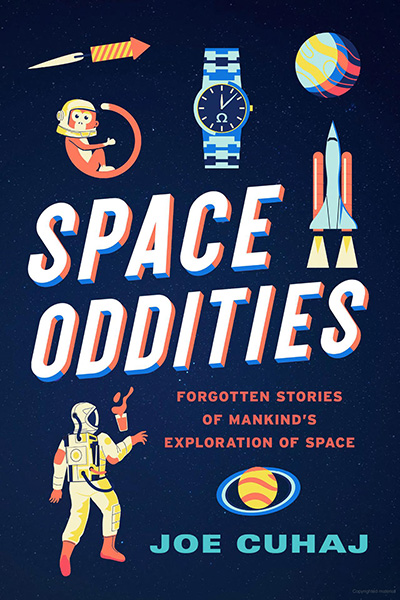By Joe Cuhaj
Prometheus Books; 2022
Paperback: $21.95
Genre: Science
Reviewed by Edward Journey

With his heavily researched Space Oddities: Forgotten Stories of Mankind’s Exploration of Space, Joe Cuhaj has tapped into the space aficionado’s desire to know even more about the exploration of the proverbial “final frontier.” The book captures the true breathless fanboy spirit of its New-Jersey born, Alabama-based author who “applied to take part in NASA’s Journalist in Space program but never heard back.” Cuhaj, a Navy veteran and retired broadcaster, is the author of several books concentrating mainly on local history, travel, and hiking.
Much trivia is included, but Space Oddities is not a book of trivia alone. The history of experiments in rocketry is traced back to eleventh-century China. Manned space travel’s origins, Icarus notwithstanding, go back to the legend of Wan Hu who, around 1500 A.D., attached his bamboo throne to forty-seven “fire arrows” which were simultaneously ignited, resulting in a huge explosion and the disappearance of Wan Hu. Wan Hu no doubt perished in the explosion, but a crater on the moon is named after him just in case. Cuhaj later documents the experiments of Max Valier, a German whose 1930 death by rocket explosion becomes “the first recorded death in modern rocketry” and whose experiments inspired a young German, Wernher von Braun.
Von Braun, Huntsville’s favorite adopted son, deservedly figures prominently in parts of the book, and Cuhaj mostly toes the American line that whitewashes von Braun’s Nazi and war crime past. Much detail is included about the pissing contest and gamesmanship that was the U.S.–Soviet space race during the Cold War. One eye-opening anecdote involves a Soviet plan to “nuke” the moon once they reached it to provide tangible and visible proof that a Soviet moon landing was not a hoax; more rational minds prevailed, and the plot was nixed.
Cuhaj’s historical perspectives examine how the various space programs operated within the social and political spheres of their times. The history of the space program is unfortunately littered with stories of shocking racism and sexism. From these barriers arise heroic stories of women and minorities who endure and prevail despite the challenges. In the early 1960s, as Civil Rights and the Space Race were running, in Cuhaj’s words, “a parallel course,” the Civil Rights movement often was upstaged by space milestones and the quest to “beat” the Soviets (who often used the racial struggles of the United States in their propaganda).
Cuhaj shares a handful of stories of individual achievements by those left out due to race or gender. Mary Wallace (Wally) Funk, who was part of the “Mercury 13 Woman in Space Program” in 1961, is one such story. Despite high achievement on rigorous endurance testing and related skills, none of the Mercury 13 women were chosen for space flight. Wally Funk finally achieved her goal in a 2021 Blue Origin suborbital flight during which, after 60 years, she reached the outer reaches of space and earned her astronaut wings.
Modern sensibilities might be startled to be reminded of the many animals who gave their lives so that humans could explore space. The most striking example might be the haunting story of Laika, an internationally beloved spitz-husky Soviet canine, who was sent on a death sentence to orbit the Earth without a reentry option. Laika was dead within seven hours of achieving Earth orbit, but her lifeless body orbited for five more months. On a happier note, Miss Baker, an American squirrel monkey, survived her space flight and lived out a long and happy life at the Alabama Space and Rocket Center where she is now buried. It is worth noting that even then animal advocates were voicing concerns about such animal exploitation.
There are plenty of engrossing stories and incidents to illuminate human intervention and, in John Kennedy’s words, “conquest” of space. Although Cuhaj doesn’t focus on it, I was struck by the amount of litter and debris our various space programs have inflicted on our universe. Perhaps, like climate change, those issues are being deferred to future generations.
Many more light-hearted chapters focus on topics like music and space, and NASA’s famous “wake-up calls” to the space stations. Who can forget Canadian astronaut Chris Hadfield’s YouTube transmission of his version of David Bowie’s “Space Oddity” from the International Space Station in 2013? But did you know that the first song performed in space was astronauts Wally Schirra and Tom Stafford’s version of “Jingle Bells” in 1965? Astronauts, by law, were allowed to take one and a half pounds of personal belongings into space. When Neil Armstrong and Buzz Aldrin landed on the moon in 1969, Aldrin used his personal allotment to bring the ingredients to hold communion on the moon when the Eagle had landed.
The hale and hearty spirit and playfulness of the astronauts and the rocket scientists during their space exploits is striking throughout Cuhaj’s text. Other chapters expose the rocket scientists’ superstitions, marketing in space (the Fisher “space pen,” Omega watches, Coke and Pepsi, Israeli milk, and Tang – of course), and the real perils of space sex, including an effort by PornHub to crowdfund the first space sex video. It hasn’t happened … yet.
For those who are obsessed with all things space, Space Oddities is full of history and anecdotes they may not have known and others that are sure to bring back memories.
Edward Journey, a retired educator and theatre professional living in Birmingham, regularly shares his essays in the online journal Professional Southerner.





